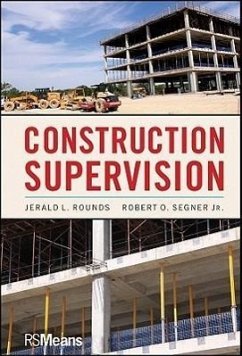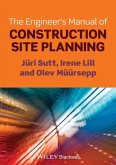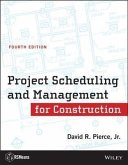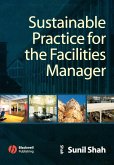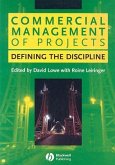- Gebundenes Buch
- Merkliste
- Auf die Merkliste
- Bewerten Bewerten
- Teilen
- Produkt teilen
- Produkterinnerung
- Produkterinnerung
Construction/Construction Management Must-have management strategies for construction supervisors working in the field Construction Supervision inspires supervisory excellence with proven tactics and techniques applied by thousands of construction supervisors over the past decade. Recognizing the unique and critical role the supervisor plays in project success, the book's leadership guidelines carve out a practical blueprint for motivating work performance and increasing productivity through effective communication. Key lessons emphasize adaptable strategies for managing risk and unexpected…mehr
Andere Kunden interessierten sich auch für
![Engineer's Manual Construction Engineer's Manual Construction]() Jüri SuttEngineer's Manual Construction93,99 €
Jüri SuttEngineer's Manual Construction93,99 €![Project Scheduling and Management for Construction Project Scheduling and Management for Construction]() David R PierceProject Scheduling and Management for Construction114,99 €
David R PierceProject Scheduling and Management for Construction114,99 €![Sustainable Practice for the Facilities Manager Sustainable Practice for the Facilities Manager]() Sunil ShahSustainable Practice for the Facilities Manager94,99 €
Sunil ShahSustainable Practice for the Facilities Manager94,99 €![Heathrow's Terminal 5 Heathrow's Terminal 5]() Sharon DohertyHeathrow's Terminal 584,99 €
Sharon DohertyHeathrow's Terminal 584,99 €![Commercial Management of Projects Commercial Management of Projects]() David Lowe / Peter FennCommercial Management of Projects237,99 €
David Lowe / Peter FennCommercial Management of Projects237,99 €![Knowledge Management Construction Knowledge Management Construction]() ANUMBA CHIMAY J / EGBU CHARLES / CARRILLO PATRICIAKnowledge Management Construction183,99 €
ANUMBA CHIMAY J / EGBU CHARLES / CARRILLO PATRICIAKnowledge Management Construction183,99 €![Programme Procurement in Construction Programme Procurement in Construction]() John MeadProgramme Procurement in Construction83,99 €
John MeadProgramme Procurement in Construction83,99 €-
-
-
Construction/Construction Management Must-have management strategies for construction supervisors working in the field Construction Supervision inspires supervisory excellence with proven tactics and techniques applied by thousands of construction supervisors over the past decade. Recognizing the unique and critical role the supervisor plays in project success, the book's leadership guidelines carve out a practical blueprint for motivating work performance and increasing productivity through effective communication. Key lessons emphasize adaptable strategies for managing risk and unexpected workflow challenges. Beginning with the definition and importance of supervision and ending with the increasingly important role construction supervisors will hold in the future, this book covers a wide range of topics, such as best practices for accomplishing project objectives, managing physical resources, schedules and costs, team building, and much more. Construction Supervision features: * A unique focus on field supervision and crew management * Coverage of supervision from the foreman to the superintendent level * An overview of technical skills whose mastery will build confidence and success for the supervisor * A detailed view of "soft" management and communication skills From planning and executing in the field to juggling responsibilities on the fly, Construction Supervision fosters preparedness with a broad range of supervisory situations one is likely to encounter on a commercial, residential, industrial, or institutional construction project, and offers sound advice for solving the most complex management issues.
Hinweis: Dieser Artikel kann nur an eine deutsche Lieferadresse ausgeliefert werden.
Hinweis: Dieser Artikel kann nur an eine deutsche Lieferadresse ausgeliefert werden.
Produktdetails
- Produktdetails
- Verlag: Wiley
- Seitenzahl: 464
- Erscheinungstermin: 5. April 2011
- Englisch
- Abmessung: 236mm x 157mm x 30mm
- Gewicht: 757g
- ISBN-13: 9780470614969
- ISBN-10: 047061496X
- Artikelnr.: 32307071
- Herstellerkennzeichnung
- Libri GmbH
- Europaallee 1
- 36244 Bad Hersfeld
- gpsr@libri.de
- Verlag: Wiley
- Seitenzahl: 464
- Erscheinungstermin: 5. April 2011
- Englisch
- Abmessung: 236mm x 157mm x 30mm
- Gewicht: 757g
- ISBN-13: 9780470614969
- ISBN-10: 047061496X
- Artikelnr.: 32307071
- Herstellerkennzeichnung
- Libri GmbH
- Europaallee 1
- 36244 Bad Hersfeld
- gpsr@libri.de
Jerald L. Rounds, PhD, PE, is Associated General Contractors Endowed Chair in Construction Management and Construction Engineering at the University of New Mexico. As a certified Class "A" construction superintendent in Denver, he served as project manager on a number of commercial building projects prior to more than thirty years as a construction educator. Concurrently, he has developed numerous training programs in project management and supervision for the construction industry. Most recently, he codeveloped the NECA Electrical Project Supervision training program with Robert Segner, with whom he has conducted "train the trainer" sessions for the past decade. Robert O. Segner Jr. is a professor of construction science in the College of Architecture at Texas A&M University. He followed years of construction practice with four decades in construction higher education. He has served as president of the American Council for Construction Education. Segner codeveloped the NECA Electrical Project Supervision training program with Jerald Rounds and has conducted "train the trainer" sessions for the past decade. He has developed and taught numerous other continuing education programs.
Preface xix
The Role of the Supervisor xix
Intended Audience xx
The Book's Structure and Organization xxi
Making the Most of the Book xxii
Acknowledgements xxiii
Section I: Setting the Stage 1
Chapter 1: Overview of the Construction Industry 3
Introduction 3
Construction Volume and Impact on Society 4
Profit, Profitability, and the Supervisor's Impact 5
Competition, Risk, and Construction Company Failure 6
Definitions and Roles of Construction Team Members 8
Becoming an Effective Supervisor 12
Summary 12
Chapter 2: Supervision and the Supervisor 15
Introduction 15
Definition of Supervisor 15
The Supervisor's Functional Role in a Construction Company 16
The Supervisor as Manager 17
Transition to Management 18
Attributes of Successful Supervisors 21
Levels of Supervision-Career Paths 23
Summary 24
Section II: Soft Skills 27
Chapter 3: Oral Communication 29
Introduction 29
Defining Communication 29
Characteristics of Communication in Construction 30
Improving One-on-One Oral Communication Skills 31
Techniques for Improving the Effectiveness of Oral Communication 35
Active Listening 37
Customer Relations 40
Who Is the Customer? 40
Respecting the Customer 41
The Art of Negotiation 41
Summary 44
Chapter 4: Written Communication and Documentation 47
Introduction 47
Why Write the Message? 48
The Functions of Job Site Documentation 48
Improving Written Communication and Documentation 49
Job Site Communication and Documentation 50
Company Office Communication and Documentation 58
Communications and Documentation Developed Outside the Company 70
Organizing Construction Documents 71
Obtaining Information and Documentation 71
Summary 73
Chapter 5: Team Building and Maintenance 75
Introduction 75
The Critical Need for Effective Construction Teams 76
The Construction Team 78
Team Characteristics 79
Team Formation 82
Maintaining Team Effectiveness 83
Practical Team Building 85
Summary 87
Chapter 6: Maintaining the Relationship Between The Employee and the
Employer 89
Introduction 89
Evaluating Performance 90
Diversity and Discrimination 101
Harassment 105
Summary 108
Chapter 7: Managing the Human Resource 111
Introduction 111
The Supervisor as a Leader 112
Styles of Leadership 114
Elements of Motivation 120
Manager, Learn to Better Understand Yourself as Well as Those around You
132
Summary 135
Chapter 8: Risk Management and Problem Solving 137
Introduction 137
Identifying and Dealing with Risk 137
Managing Risk 141
Problem Solving 142
Summary 151
Section III: Technical Skills 153
Chapter 9: Safety 155
Introduction 155
Accidents, Incidents, and Safety Risk 156
The Importance of a Construction Safety Program 156
The Supervisor's Safety Responsibilities and Activities 158
Creating a Safe Work Environment by Removing Job Hazards 159
Developing a Mentality of Safety 163
Effectively Dealing with Safety Events 166
Summary 167
Chapter 10: The Contract as a Management Tool 169
Introduction 169
A Practical Understanding of the Contract 170
Required Elements for an Enforceable Contract 172
Components of the Construction Contract 173
Contract Couplets 174
Reading the Contract 176
Using the Contract 178
Summary 181
Chapter 11: Managing Physical Resources 185
Introduction 185
Managing Manpower 185
Managing Materials 189
Managing Tools and Equipment 194
Managing the Construction Site 195
Cash as a Resource 197
Managing Time on a Construction Project 199
Summary 199
Chapter 12: Managing Costs: Understanding the Estimate 201
Introduction 201
The Estimate 201
Types of Estimates 202
Truisms Regarding the Estimate 203
Preparing the Estimate 204
The Detailed Estimate 205
Preparing the Detailed Estimate 206
Finalizing and Submitting the Estimate 217
Summary 218
Chapter 13: Managing Costs Control 221
Elements of Cost
Introduction 221
The System Is a Cycle 221
The Project Budget and the Project Labor Budget 225
Labor Cost Reports 228
The Cycle Continues 233
Project Review 234
Summary 235
Chapter 14: Managing Time on a Construction Project 237
Introduction 237
Scheduling Defined 238
The Schedule as a Planning Tool 239
Importance of the Schedule 239
Types of Schedules 240
The Critical Path Method (CPM) 252
Development of a Network Schedule and the Critical Path 256
Basic Truisms with Regard to the Critical Path 274
Network Schedule Updates 274
Short-Interval Schedules 275
Summary 277
Chapter 15: Managing Production 279
Introduction 279
Understanding Production and Productivity 280
Improving Production 281
Improving Production in an Ongoing Activity 282
Designing a More Efficient Task 289
Improving Construction Operations 292
Summary 299
Section IV: Project Supervision 301
Chapter 16: Project Organization 303
Introduction 303
Types of Projects 303
Other Classifications-Types of Contractors 304
Project Delivery Methods 305
Types of Construction Contracts 314
Forms of Construction Contract Award 316
Other Forms of Contracts 327
Project Organization and Relationships 327
Subcontractor's Project Organization 331
Summary 331
Chapter 17: Mobilization 335
Introduction 335
Handoff from Preconstruction to Construction-Handoff Meetings 335
Preconstruction Conference 336
Setting Up the Site 338
Setting Up the Field Office 339
Establishing Field Procedures 341
Project Objectives 341
Summary 343
Chapter 18: Ongoing Operations 345
Introduction 345
Documenting 346
Reporting 349
Retainage 360
Meetings 360
Changes in the Work 362
Quality, Quality Assurance, and Quality Control 363
Summary 367
Chapter 19: Closeout of Field Operations 369
Introduction 369
Project Cleanup 370
The Commissioning Process 370
Developing Final Documentation 373
Closing Out Subcontractors and Suppliers 376
Final Request for Payment 377
The Certificate of Occupancy 377
Certificate of Substantial Completion 378
Project Review 379
Summary 380
Chapter 20: the Supervisor's Continuing Development 383
Introduction 383
Change in the Construction Industry 383
Recruiting and Preparing Construction Supervisors 389
Staying Ahead of the Curve 390
Summary 394
Appendix 1: Consensusdocs 750: Standard Form Of Agreement Between
Contractor And Subcontractor 397
Appendix 2: Simple Filing System 431
Index 433
The Role of the Supervisor xix
Intended Audience xx
The Book's Structure and Organization xxi
Making the Most of the Book xxii
Acknowledgements xxiii
Section I: Setting the Stage 1
Chapter 1: Overview of the Construction Industry 3
Introduction 3
Construction Volume and Impact on Society 4
Profit, Profitability, and the Supervisor's Impact 5
Competition, Risk, and Construction Company Failure 6
Definitions and Roles of Construction Team Members 8
Becoming an Effective Supervisor 12
Summary 12
Chapter 2: Supervision and the Supervisor 15
Introduction 15
Definition of Supervisor 15
The Supervisor's Functional Role in a Construction Company 16
The Supervisor as Manager 17
Transition to Management 18
Attributes of Successful Supervisors 21
Levels of Supervision-Career Paths 23
Summary 24
Section II: Soft Skills 27
Chapter 3: Oral Communication 29
Introduction 29
Defining Communication 29
Characteristics of Communication in Construction 30
Improving One-on-One Oral Communication Skills 31
Techniques for Improving the Effectiveness of Oral Communication 35
Active Listening 37
Customer Relations 40
Who Is the Customer? 40
Respecting the Customer 41
The Art of Negotiation 41
Summary 44
Chapter 4: Written Communication and Documentation 47
Introduction 47
Why Write the Message? 48
The Functions of Job Site Documentation 48
Improving Written Communication and Documentation 49
Job Site Communication and Documentation 50
Company Office Communication and Documentation 58
Communications and Documentation Developed Outside the Company 70
Organizing Construction Documents 71
Obtaining Information and Documentation 71
Summary 73
Chapter 5: Team Building and Maintenance 75
Introduction 75
The Critical Need for Effective Construction Teams 76
The Construction Team 78
Team Characteristics 79
Team Formation 82
Maintaining Team Effectiveness 83
Practical Team Building 85
Summary 87
Chapter 6: Maintaining the Relationship Between The Employee and the
Employer 89
Introduction 89
Evaluating Performance 90
Diversity and Discrimination 101
Harassment 105
Summary 108
Chapter 7: Managing the Human Resource 111
Introduction 111
The Supervisor as a Leader 112
Styles of Leadership 114
Elements of Motivation 120
Manager, Learn to Better Understand Yourself as Well as Those around You
132
Summary 135
Chapter 8: Risk Management and Problem Solving 137
Introduction 137
Identifying and Dealing with Risk 137
Managing Risk 141
Problem Solving 142
Summary 151
Section III: Technical Skills 153
Chapter 9: Safety 155
Introduction 155
Accidents, Incidents, and Safety Risk 156
The Importance of a Construction Safety Program 156
The Supervisor's Safety Responsibilities and Activities 158
Creating a Safe Work Environment by Removing Job Hazards 159
Developing a Mentality of Safety 163
Effectively Dealing with Safety Events 166
Summary 167
Chapter 10: The Contract as a Management Tool 169
Introduction 169
A Practical Understanding of the Contract 170
Required Elements for an Enforceable Contract 172
Components of the Construction Contract 173
Contract Couplets 174
Reading the Contract 176
Using the Contract 178
Summary 181
Chapter 11: Managing Physical Resources 185
Introduction 185
Managing Manpower 185
Managing Materials 189
Managing Tools and Equipment 194
Managing the Construction Site 195
Cash as a Resource 197
Managing Time on a Construction Project 199
Summary 199
Chapter 12: Managing Costs: Understanding the Estimate 201
Introduction 201
The Estimate 201
Types of Estimates 202
Truisms Regarding the Estimate 203
Preparing the Estimate 204
The Detailed Estimate 205
Preparing the Detailed Estimate 206
Finalizing and Submitting the Estimate 217
Summary 218
Chapter 13: Managing Costs Control 221
Elements of Cost
Introduction 221
The System Is a Cycle 221
The Project Budget and the Project Labor Budget 225
Labor Cost Reports 228
The Cycle Continues 233
Project Review 234
Summary 235
Chapter 14: Managing Time on a Construction Project 237
Introduction 237
Scheduling Defined 238
The Schedule as a Planning Tool 239
Importance of the Schedule 239
Types of Schedules 240
The Critical Path Method (CPM) 252
Development of a Network Schedule and the Critical Path 256
Basic Truisms with Regard to the Critical Path 274
Network Schedule Updates 274
Short-Interval Schedules 275
Summary 277
Chapter 15: Managing Production 279
Introduction 279
Understanding Production and Productivity 280
Improving Production 281
Improving Production in an Ongoing Activity 282
Designing a More Efficient Task 289
Improving Construction Operations 292
Summary 299
Section IV: Project Supervision 301
Chapter 16: Project Organization 303
Introduction 303
Types of Projects 303
Other Classifications-Types of Contractors 304
Project Delivery Methods 305
Types of Construction Contracts 314
Forms of Construction Contract Award 316
Other Forms of Contracts 327
Project Organization and Relationships 327
Subcontractor's Project Organization 331
Summary 331
Chapter 17: Mobilization 335
Introduction 335
Handoff from Preconstruction to Construction-Handoff Meetings 335
Preconstruction Conference 336
Setting Up the Site 338
Setting Up the Field Office 339
Establishing Field Procedures 341
Project Objectives 341
Summary 343
Chapter 18: Ongoing Operations 345
Introduction 345
Documenting 346
Reporting 349
Retainage 360
Meetings 360
Changes in the Work 362
Quality, Quality Assurance, and Quality Control 363
Summary 367
Chapter 19: Closeout of Field Operations 369
Introduction 369
Project Cleanup 370
The Commissioning Process 370
Developing Final Documentation 373
Closing Out Subcontractors and Suppliers 376
Final Request for Payment 377
The Certificate of Occupancy 377
Certificate of Substantial Completion 378
Project Review 379
Summary 380
Chapter 20: the Supervisor's Continuing Development 383
Introduction 383
Change in the Construction Industry 383
Recruiting and Preparing Construction Supervisors 389
Staying Ahead of the Curve 390
Summary 394
Appendix 1: Consensusdocs 750: Standard Form Of Agreement Between
Contractor And Subcontractor 397
Appendix 2: Simple Filing System 431
Index 433
Preface xix
The Role of the Supervisor xix
Intended Audience xx
The Book's Structure and Organization xxi
Making the Most of the Book xxii
Acknowledgements xxiii
Section I: Setting the Stage 1
Chapter 1: Overview of the Construction Industry 3
Introduction 3
Construction Volume and Impact on Society 4
Profit, Profitability, and the Supervisor's Impact 5
Competition, Risk, and Construction Company Failure 6
Definitions and Roles of Construction Team Members 8
Becoming an Effective Supervisor 12
Summary 12
Chapter 2: Supervision and the Supervisor 15
Introduction 15
Definition of Supervisor 15
The Supervisor's Functional Role in a Construction Company 16
The Supervisor as Manager 17
Transition to Management 18
Attributes of Successful Supervisors 21
Levels of Supervision-Career Paths 23
Summary 24
Section II: Soft Skills 27
Chapter 3: Oral Communication 29
Introduction 29
Defining Communication 29
Characteristics of Communication in Construction 30
Improving One-on-One Oral Communication Skills 31
Techniques for Improving the Effectiveness of Oral Communication 35
Active Listening 37
Customer Relations 40
Who Is the Customer? 40
Respecting the Customer 41
The Art of Negotiation 41
Summary 44
Chapter 4: Written Communication and Documentation 47
Introduction 47
Why Write the Message? 48
The Functions of Job Site Documentation 48
Improving Written Communication and Documentation 49
Job Site Communication and Documentation 50
Company Office Communication and Documentation 58
Communications and Documentation Developed Outside the Company 70
Organizing Construction Documents 71
Obtaining Information and Documentation 71
Summary 73
Chapter 5: Team Building and Maintenance 75
Introduction 75
The Critical Need for Effective Construction Teams 76
The Construction Team 78
Team Characteristics 79
Team Formation 82
Maintaining Team Effectiveness 83
Practical Team Building 85
Summary 87
Chapter 6: Maintaining the Relationship Between The Employee and the
Employer 89
Introduction 89
Evaluating Performance 90
Diversity and Discrimination 101
Harassment 105
Summary 108
Chapter 7: Managing the Human Resource 111
Introduction 111
The Supervisor as a Leader 112
Styles of Leadership 114
Elements of Motivation 120
Manager, Learn to Better Understand Yourself as Well as Those around You
132
Summary 135
Chapter 8: Risk Management and Problem Solving 137
Introduction 137
Identifying and Dealing with Risk 137
Managing Risk 141
Problem Solving 142
Summary 151
Section III: Technical Skills 153
Chapter 9: Safety 155
Introduction 155
Accidents, Incidents, and Safety Risk 156
The Importance of a Construction Safety Program 156
The Supervisor's Safety Responsibilities and Activities 158
Creating a Safe Work Environment by Removing Job Hazards 159
Developing a Mentality of Safety 163
Effectively Dealing with Safety Events 166
Summary 167
Chapter 10: The Contract as a Management Tool 169
Introduction 169
A Practical Understanding of the Contract 170
Required Elements for an Enforceable Contract 172
Components of the Construction Contract 173
Contract Couplets 174
Reading the Contract 176
Using the Contract 178
Summary 181
Chapter 11: Managing Physical Resources 185
Introduction 185
Managing Manpower 185
Managing Materials 189
Managing Tools and Equipment 194
Managing the Construction Site 195
Cash as a Resource 197
Managing Time on a Construction Project 199
Summary 199
Chapter 12: Managing Costs: Understanding the Estimate 201
Introduction 201
The Estimate 201
Types of Estimates 202
Truisms Regarding the Estimate 203
Preparing the Estimate 204
The Detailed Estimate 205
Preparing the Detailed Estimate 206
Finalizing and Submitting the Estimate 217
Summary 218
Chapter 13: Managing Costs Control 221
Elements of Cost
Introduction 221
The System Is a Cycle 221
The Project Budget and the Project Labor Budget 225
Labor Cost Reports 228
The Cycle Continues 233
Project Review 234
Summary 235
Chapter 14: Managing Time on a Construction Project 237
Introduction 237
Scheduling Defined 238
The Schedule as a Planning Tool 239
Importance of the Schedule 239
Types of Schedules 240
The Critical Path Method (CPM) 252
Development of a Network Schedule and the Critical Path 256
Basic Truisms with Regard to the Critical Path 274
Network Schedule Updates 274
Short-Interval Schedules 275
Summary 277
Chapter 15: Managing Production 279
Introduction 279
Understanding Production and Productivity 280
Improving Production 281
Improving Production in an Ongoing Activity 282
Designing a More Efficient Task 289
Improving Construction Operations 292
Summary 299
Section IV: Project Supervision 301
Chapter 16: Project Organization 303
Introduction 303
Types of Projects 303
Other Classifications-Types of Contractors 304
Project Delivery Methods 305
Types of Construction Contracts 314
Forms of Construction Contract Award 316
Other Forms of Contracts 327
Project Organization and Relationships 327
Subcontractor's Project Organization 331
Summary 331
Chapter 17: Mobilization 335
Introduction 335
Handoff from Preconstruction to Construction-Handoff Meetings 335
Preconstruction Conference 336
Setting Up the Site 338
Setting Up the Field Office 339
Establishing Field Procedures 341
Project Objectives 341
Summary 343
Chapter 18: Ongoing Operations 345
Introduction 345
Documenting 346
Reporting 349
Retainage 360
Meetings 360
Changes in the Work 362
Quality, Quality Assurance, and Quality Control 363
Summary 367
Chapter 19: Closeout of Field Operations 369
Introduction 369
Project Cleanup 370
The Commissioning Process 370
Developing Final Documentation 373
Closing Out Subcontractors and Suppliers 376
Final Request for Payment 377
The Certificate of Occupancy 377
Certificate of Substantial Completion 378
Project Review 379
Summary 380
Chapter 20: the Supervisor's Continuing Development 383
Introduction 383
Change in the Construction Industry 383
Recruiting and Preparing Construction Supervisors 389
Staying Ahead of the Curve 390
Summary 394
Appendix 1: Consensusdocs 750: Standard Form Of Agreement Between
Contractor And Subcontractor 397
Appendix 2: Simple Filing System 431
Index 433
The Role of the Supervisor xix
Intended Audience xx
The Book's Structure and Organization xxi
Making the Most of the Book xxii
Acknowledgements xxiii
Section I: Setting the Stage 1
Chapter 1: Overview of the Construction Industry 3
Introduction 3
Construction Volume and Impact on Society 4
Profit, Profitability, and the Supervisor's Impact 5
Competition, Risk, and Construction Company Failure 6
Definitions and Roles of Construction Team Members 8
Becoming an Effective Supervisor 12
Summary 12
Chapter 2: Supervision and the Supervisor 15
Introduction 15
Definition of Supervisor 15
The Supervisor's Functional Role in a Construction Company 16
The Supervisor as Manager 17
Transition to Management 18
Attributes of Successful Supervisors 21
Levels of Supervision-Career Paths 23
Summary 24
Section II: Soft Skills 27
Chapter 3: Oral Communication 29
Introduction 29
Defining Communication 29
Characteristics of Communication in Construction 30
Improving One-on-One Oral Communication Skills 31
Techniques for Improving the Effectiveness of Oral Communication 35
Active Listening 37
Customer Relations 40
Who Is the Customer? 40
Respecting the Customer 41
The Art of Negotiation 41
Summary 44
Chapter 4: Written Communication and Documentation 47
Introduction 47
Why Write the Message? 48
The Functions of Job Site Documentation 48
Improving Written Communication and Documentation 49
Job Site Communication and Documentation 50
Company Office Communication and Documentation 58
Communications and Documentation Developed Outside the Company 70
Organizing Construction Documents 71
Obtaining Information and Documentation 71
Summary 73
Chapter 5: Team Building and Maintenance 75
Introduction 75
The Critical Need for Effective Construction Teams 76
The Construction Team 78
Team Characteristics 79
Team Formation 82
Maintaining Team Effectiveness 83
Practical Team Building 85
Summary 87
Chapter 6: Maintaining the Relationship Between The Employee and the
Employer 89
Introduction 89
Evaluating Performance 90
Diversity and Discrimination 101
Harassment 105
Summary 108
Chapter 7: Managing the Human Resource 111
Introduction 111
The Supervisor as a Leader 112
Styles of Leadership 114
Elements of Motivation 120
Manager, Learn to Better Understand Yourself as Well as Those around You
132
Summary 135
Chapter 8: Risk Management and Problem Solving 137
Introduction 137
Identifying and Dealing with Risk 137
Managing Risk 141
Problem Solving 142
Summary 151
Section III: Technical Skills 153
Chapter 9: Safety 155
Introduction 155
Accidents, Incidents, and Safety Risk 156
The Importance of a Construction Safety Program 156
The Supervisor's Safety Responsibilities and Activities 158
Creating a Safe Work Environment by Removing Job Hazards 159
Developing a Mentality of Safety 163
Effectively Dealing with Safety Events 166
Summary 167
Chapter 10: The Contract as a Management Tool 169
Introduction 169
A Practical Understanding of the Contract 170
Required Elements for an Enforceable Contract 172
Components of the Construction Contract 173
Contract Couplets 174
Reading the Contract 176
Using the Contract 178
Summary 181
Chapter 11: Managing Physical Resources 185
Introduction 185
Managing Manpower 185
Managing Materials 189
Managing Tools and Equipment 194
Managing the Construction Site 195
Cash as a Resource 197
Managing Time on a Construction Project 199
Summary 199
Chapter 12: Managing Costs: Understanding the Estimate 201
Introduction 201
The Estimate 201
Types of Estimates 202
Truisms Regarding the Estimate 203
Preparing the Estimate 204
The Detailed Estimate 205
Preparing the Detailed Estimate 206
Finalizing and Submitting the Estimate 217
Summary 218
Chapter 13: Managing Costs Control 221
Elements of Cost
Introduction 221
The System Is a Cycle 221
The Project Budget and the Project Labor Budget 225
Labor Cost Reports 228
The Cycle Continues 233
Project Review 234
Summary 235
Chapter 14: Managing Time on a Construction Project 237
Introduction 237
Scheduling Defined 238
The Schedule as a Planning Tool 239
Importance of the Schedule 239
Types of Schedules 240
The Critical Path Method (CPM) 252
Development of a Network Schedule and the Critical Path 256
Basic Truisms with Regard to the Critical Path 274
Network Schedule Updates 274
Short-Interval Schedules 275
Summary 277
Chapter 15: Managing Production 279
Introduction 279
Understanding Production and Productivity 280
Improving Production 281
Improving Production in an Ongoing Activity 282
Designing a More Efficient Task 289
Improving Construction Operations 292
Summary 299
Section IV: Project Supervision 301
Chapter 16: Project Organization 303
Introduction 303
Types of Projects 303
Other Classifications-Types of Contractors 304
Project Delivery Methods 305
Types of Construction Contracts 314
Forms of Construction Contract Award 316
Other Forms of Contracts 327
Project Organization and Relationships 327
Subcontractor's Project Organization 331
Summary 331
Chapter 17: Mobilization 335
Introduction 335
Handoff from Preconstruction to Construction-Handoff Meetings 335
Preconstruction Conference 336
Setting Up the Site 338
Setting Up the Field Office 339
Establishing Field Procedures 341
Project Objectives 341
Summary 343
Chapter 18: Ongoing Operations 345
Introduction 345
Documenting 346
Reporting 349
Retainage 360
Meetings 360
Changes in the Work 362
Quality, Quality Assurance, and Quality Control 363
Summary 367
Chapter 19: Closeout of Field Operations 369
Introduction 369
Project Cleanup 370
The Commissioning Process 370
Developing Final Documentation 373
Closing Out Subcontractors and Suppliers 376
Final Request for Payment 377
The Certificate of Occupancy 377
Certificate of Substantial Completion 378
Project Review 379
Summary 380
Chapter 20: the Supervisor's Continuing Development 383
Introduction 383
Change in the Construction Industry 383
Recruiting and Preparing Construction Supervisors 389
Staying Ahead of the Curve 390
Summary 394
Appendix 1: Consensusdocs 750: Standard Form Of Agreement Between
Contractor And Subcontractor 397
Appendix 2: Simple Filing System 431
Index 433

